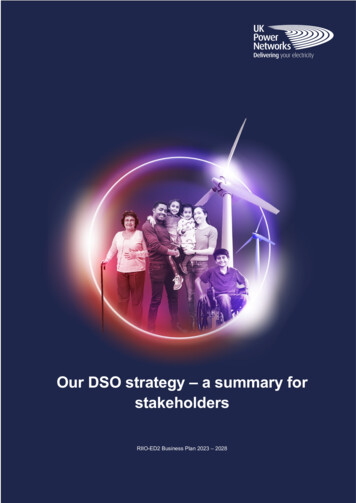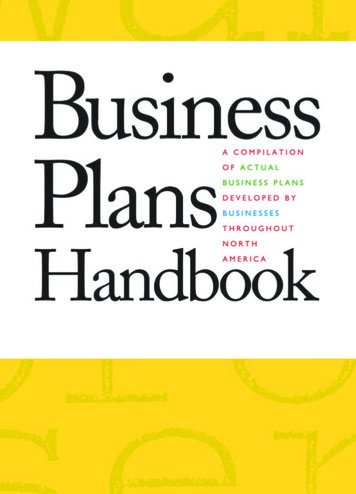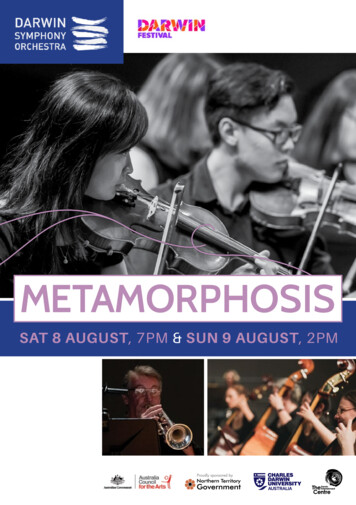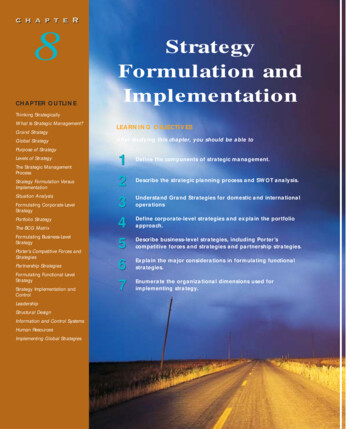
Transcription
Our DSO strategy – a summary forstakeholdersRIIO-ED2 Business Plan 2023 – 2028
2 RIIO-ED2 Business Plan 2023 – 20281Executive Summary32The challenges and market context that have shaped our strategy102.1Our RIIO-ED1 track record102.2The changing energy landscape112.3The evolution of the energy market142.4Our vision for the DSO’s role in the future energy system162.5How these challenges and trends have shaped our DSO strategy263Our DSO strategy and proposals for RIIO-ED2293.1Our commitments under the four pillars of our DSO strategy293.2Building trust through transparency323.2.1A stakeholder summary of our proposals323.2.2Our proposed commitments and metrics for delivering transparency343.3Role 1: Planning & Network Development363.3.1How our proposals for Role 1 deliver against Ofgem’s expectations363.3.2A stakeholder summary of our proposals for Role 1363.3.3Our proposed commitments and metrics for Role 1443.4Role 2: Network Operation463.4.1How our proposals for Role 2 deliver against Ofgem’s expectations463.4.2A stakeholder summary of our proposals for Role 2463.4.3Our proposed commitments, and metrics for Role 2513.5Role 3: Market Development533.5.1How our proposals for Role 3 deliver against Ofgem’s expectations533.5.2A stakeholder summary of our proposals for Role 3533.5.3Our proposed commitments, and metrics for Role 358
3 RIIO-ED2 Business Plan 2023 – 2028Facilitating the transition to Net Zero and supporting clean economic growth, at lowest costGovernment climate targets require a radical shift in the way that everyone in Britain consumes energy. In turn, this will requirea significant increase in the volume of Distributed Energy Resources (renewables, storage, electric vehicles, heat pumps)connected to our networks.Our vision is of a dynamic distribution system, with electricity demand and supply flexing in response to distibution-levelconditions and wider market signals. We will see market based solutions incentivising customers to utilise available networkcapactiy efficiently, being supplemented with traditional network investment that results in the lowest costs for consumersoverall. This will lead to a smarter and more highly utilised distribution network, with faster and cheaper access for the DERswe will need to achieve Net Zero.This is a radical departure from the traditional thinking that has guided networks over the last 100 years, which has been tobuild new network as the default solution. We will need to continue to innovate, thinking in new ways, being more dynamicand agile in line with changing customer requirements and new technology, and working in much stronger collaboration withothers to deliver whole system outcomes.We see our Distribution System Operator (DSO) being at the heart of facilitating the transition to Net Zero at lowest cost, whilstsupporting clean economic growth. In our business plan, we set out the four pillars of our DSO Strategy, and our commitmentsunder each. Those pillars are:Our DSO will also support the delivery of wider strategies, and so this document should be considered in conjunction withwider published appendices to our business plan – Appendix 19a: Whole systems strategy, Appendix 8: Vulnerability strategy,Appendix 9: Our major connections strategy, and Appendix 15: Competition.A DSO that delivers value for money for consumersThe Government’s recent Energy White Paper has signalled that smart systems and distribution-level flexibility markets willbe pivotal to ensuring the Net Zero target is achieved by 2050 at lowest cost.Our DSO strategy represents an ambitious programme to facilitate the delivery of Net Zero at lowest cost. It will deliver savingsinto our RIIO-ED2 plan and in future price control periods, and hence we have undertaken cost benefit analysis out to 2040.Through coordination with the ESO and other industry players it will also facilitate the delivery of wider system savings, andplay a vital role in helping to reduce costs across the energy system from optimal use of flexibility on our networks.In RIIO-ED2, our DSO investments will allow us to defer or avoid the following expenditure from our business plan, reducingcosts to our customers accordingly:1.2.3. 410m of capital investment on the primary and secondary network, enabled by making greater use of flexibility. 185m of capital investment to facilitate distributed, enabled through the use of innovative flexible connections. 6m of additional secondary reinforcement through the use of enhanced modelling and data analytics to inform ourinvestment decisions.The DSO investments we are making now and in ED2 will allow us to continue to defer and avoid network expenditure beyondthe ED2 period. As load growth increases over that time-period, the cost savings delivered by our DSO investments willincrease.In addition to our investment savings, our DSO programme will help deliver whole system benefits. The ESO has identifiedaround 2bn of savings from its RIIO2 business plan. We have calculated, and validated with the ESO, that 170m of ESOrelated benefits are expected to flow from our DSO strategy, through expanding the Regional Development Programmes,
4 RIIO-ED2 Business Plan 2023 – 2028providing timely network access for DER, and coordinating system operations across the T-D boundary. We have ensuredthat our DSO investments not only deliver these benefits within the RIIO-ED2 period but continue to do so in the future. Workingwith the ESO 1, we have calculated that these deliver between 470m and 580m of benefits out to 2040.Based on the savings in our RIIO-ED2 business plan and the wider system savings we arehelping the ESO deliver, we have high confidence that our DSO will deliver a net benefit(benefits generated less the DSO costs) of 560-670m out to 2040 on a NPV basis.In addition, through optimal use of flexibility on the distribution network we can help avoidwider system costs, such as reducing the amount of generation (and storage) capacityneeded to meet peak demand. We have worked with the Carbon Trust and Imperial Collegeto leverage the analysis in their recent study “Flexibility in GB” 2 to understand what quantumof the 9.6-16.7bn of flexibility benefits in 2050 could be attributed to UK Power Networks’DSO. We estimate this to be between 230m and 2.0bn out to 2040. Including thesewider system benefits within our CBA increases the overall positive NPV of our DSOstrategy to between 780m and 2.6bn out to 2040.DSO Net benefits (to2040):High confidence NPVbenefits: 560-670mTotal including widersystem PV benefits:Building trust through transparencyThe DSO will be responsible for planning our Net Zero future system and establishing markets for flexibility and accessproducts that can create more network capacity at lower cost, whilst meeting the evolving needs of our customers. To createtrust in our ability to operate market functions independently of our network business our customers expect a high degree oftransparency in how our DSO will operate.At present, our DSO-related activities are conducted from several areas in our business. This approach has served us well todate, enabling a clear focus internally for innovation in flexibility services and new connection products, whilst also gaininggood feedback from stakeholders, customers, and flexibility service providers. However, in development of our DSO Strategyfor RIIO-ED2 we have undertaken further extensive stakeholder engagement and worked through an operating model designprocess. Our conclusion from undertaking this work is that there are several challenges in continuing with the current modelin which DSO functionality is embedded in the DNO business.Whilst transparency delivered through clear processes and data publication will go some way to providingconfidence, it will not address the perceived conflict of interest inherent in any model in which the DSO is ultimatelygoverned by the DNO. It will also result in Directors who hold accountabilities for both DSO and DNO outcomes, leading toreduced transparency in decision making, and potentially raising questions over how the best outcomes for customers havebeen achieved if all decision makers in the process have dual responsibilities.Our experience pushing ahead with our DSO development has shown us that delivering a fully-fledged DSO operation will bea transformative change challenge, and we believe that any model based on incremental evolution ‘in the line’ will not createthe focus, commercial mind-set, customer centricity, and step change in ambition required to succeed. It will also fail toconfront instances where processes are not clear and grey areas in decision making exist.Having considered the costs and benefits of a range of operating model options, and informed our thinking through a rigorousdesign process, we have concluded that to be successful a DSO must be established at least as a fully ring-fenced entity.Given that stakeholders are telling us that delivering transparency is critical to achieving the benefits of the DSO, it is clearthat the minimal incremental costs of full legal separation are both warranted and appropriate, and the feedback we havereceived since the publication of our July submission has reinforced this view. We know that our strategy has generated alot of discussion in the industry with “traditionalists” suggesting that we are not serious or that “it can’t be done.”Our operating model work has not only helped us to understand specifically how a legally separate DSO couldfunction; it has reinforced our confidence that it can be done, and we will set the bar for the industry.We are therefore setting out what we believe to be the UK’s first clearly defined operating model of how a legally separateDSO could work in the best interests of customers. Our operating model for the beginning of RIIO-ED2 is based on the followingkey foundational actions:1.2.3.12Key organisational changes to create an agile, transparent, DSO business unit within UK Power Networks on day 1 ofRIIO-ED2 with clear accountabilities, set-up as a separate legal entity within UK Power Networks Group with appropriategovernance and controls.Development and publication of a DSO:DNO Operational Agreement (modelled on the SO-TO Code) setting out keyinteractions and encompassing our transparent process across all roles and how they are governed.An independent DSO Supervisory Board, which will provide assurance of our compliance with the DSO:DNOOperational Agreement, represent the views of our customers and stakeholders, and ensure that customers get theESO RIIO-2 CBA report (nationalgrideso.com)Flexibility in GB report.pdf (storage.googleapis.com)
5 RIIO-ED2 Business Plan 2023 – 2028best-value solutions. The independent DSO Supervisory Board will review and approve key DSO investment decisionsto provide extra assurance that the best-value solutions for all customers are taken forward.This clear separation between DSO and DNO business units significantly exceeds Ofgem’s baseline expectations fortransparency. We believe that establishing a legally separate DSO will foster confidence in our decision making, thusstimulating greater engagement and competition, and the clear accountabilities and incentives on individuals will lead us tomaximise the benefits of our investments in DSO capabilities.This separation has enabled us to develop clear accountabilities for the DSO and DNO across all DSO roles – for instance inhow decisions are made for network development (with the DSO accountable for the cost of network expansion, and the DNOaccountable for reliability and delivery efficiency), how flexibility service dispatch decisions are made in operational timeframes,and how Distribution Market Operations functions can be carried out via a partnership with an independently owned platformprovider.Commitment DSO1: We will build trust and confidence by establishing a legally separate DSO business unit by2023, creating an independent DSO Supervisory Board, and through our annual DSO forward plan of action.We will measure our compliance against the DSO:DNO Operational Agreement, targeting 100% complianceduring RIIO-ED2 and reporting on this annually for transparency.Alongside operational measures, our engagement showed the importance of being transparent on our progress in deliveringfor our customers. We have therefore committed to developing an annual DSO forward plan, and a stakeholder satisfactionmeasure focused on the performance of the DSO function.Commitment DSO6: We will develop a new DSO stakeholder satisfaction survey. Once we establish a baselineat the start of RIIO-ED2 we commit to improving our score by at least 10% over the period and publishing anannual DSO forward plan that will explain how we are responding to stakeholders’ priorities.Our customers and stakeholders are also telling us that they want access to as much data as we can possibly share withthem. UK Power Networks wants to be recognised as the driving force enabling the market to develop the tools they want, byproviding the data required to support their development 3.Commitment DSO8: We will be the UK’s leading DSO in network data provision through a best practice servicethat opens data according to user priorities and customer value-add. Our ability to meet users’ data needs willbe measured as part of an annual stakeholder survey from the start of RIIO-ED2.Role 1: Planning & Network DevelopmentOur primary challenge in the next decade will be enabling the rapid uptake of DER to facilitate delivery of the UK’s Net Zeroambitions, through maximising the use of existing capacity, wherever possible, and the timely release of additional capacity.This will need to be achieved whilst delivering network safety, security, and reliability and at best value for consumers.Our goal is to deliver an open, transparent, and competitive network development approach, building strong partnerships toanticipate needs and to deliver them quickly. To enable this, we will need greater visibility of the network; an enhanced suiteof planning and forecasting tools, data, and outputs; and whole system planning framework that considers all solution optionson a level playing field.Network VisibilityWe will deliver 100% coverage of the LV network through a combination of LV monitoring, and advanced analyticsusing smart meter data for the remainder of the network. Armed with this greater visibility, we will utilise smart solutions andflexibility to increase network utilisation and only reinforce the network when there is evidence of no other economic alternative.Commitment DSO5: We will collect real time data through monitoring in all LV networks where we areforecasting constraints over RIIO-ED2 and will target 100% coverage of the rest of the network throughadvanced analytics using smart meter data. This will give us better insight to run the network at higherutilisation and to defer reinforcement actions for as long as possible.Our data best practice strategy (Appendix 17b) sets out the foundational investments we are planning to deliver in order to ensure reliable,accessible and interoperable data for our targeted smart-grid capabilities. Our Digitalisation strategy (Appendix 17a) will also support our DSOin improving the way that we share data, whilst also ensuring that we meet international best practice standards.3
6 RIIO-ED2 Business Plan 2023 – 2028Our ambitious programme is using state-of-the-art analytics to maximise use of data and targets physical monitoring at thelocations that are forecast for LCT clustering under our highest modelled scenario. This combination of actions provides thevisibility required to effectively deploy flexibility and actively manage the network during RIIO-ED2 at an efficient cost. Underour proposals, by the end of RIIO-ED2, 30% of our underground low voltage transformers will be monitored in real-time, andwe will have visibility of modelled demand across 100% of the underground and overhead networks through predictiveanalytics. This allows a significant proportion of LV open data to be shared with stakeholders to stimulate flexibility andinnovation.Our approach is designed to stay ahead of the LCT load growth curve through fully embedding the processes, culture, digitalskills, capabilities and tools that DSOs need to make use of data. We believe that this approach drives short-term benefits inrequiring less physical monitoring to be deployed ahead of need, but more importantly long-term efficiencies as similarapproaches will be applicable to many other DSO challenges.Open dataAlongside our suite of planning outputs, it is imperative that customers and stakeholders have access to data such as networktopology, capacity heat maps, and asset data to assist them in planning their operations. Stakeholders told us that they wantopen, accessible and accurate information, and as much of it as possible, proactively shared in the format they want. In thisstrategy we set out the planning data items that we intend to publish through our data portal and DSO Dashboard 4.Whole system planningWe will continue to enhance our suite of planning tools and outputs, evolving our Distribution Future Energy Scenarios (DFES)with stakeholders, and establish a Distribution System Operability Framework (DSOF) as a core part of our planningoutputs, to enable greater visibility of our service needs to stakeholders, thus stimulating investment in future services.We will establish a 20-strong Local Area Energy Planning (LAEP) team to provide expertise and data support to the127 Local and Regional Authorities in our areas, and support them in developing the clarity and confidence required toincorporate their proposals for delivering Net Zero into our investment plan, as set out in our Whole Systems Strategy(appendix 19a to our business plan).When it looks likely that we will exhaust the capacity in the existing network, we will utilise market-based flexibility solutionsto create capacity at lowest cost. Our DSO will run an open Distribution Network Options Assessment (DNOA) process,consulting on scenarios for system needs and comparing flexibility and whole system solutions sourced from the market withasset-based solutions provided by the DNO (and in future also by third party network operators). We will do this all the waydown to the low voltage network to maximise opportunity for domestic level participation and cost savings for consumers.In our proposals, our DSO will take accountability for the cost of delivering new network capacity (across both assetand service solutions) and the DNO will take accountability for reliability and delivery efficiency. This clear distinctionin objectives across the DSO and DNO should help reveal inherent trade-offs between cost and reliability, and in doing sodeliver the right level of supply reliability to the customer at the right price.We will drive competition everywhere we feasibly can. Our DSO’s core role is to open new markets to competition todeliver best value for consumers. For the benefit of consumers, this is not limited to introducing flexibility services, butwe are now also proposing to the construction of DNO assets. As we explain in Chapter 15: Competition in our RIIO-ED2business plan, we have made a DNO-first commitment to tender construction of major load and connections-driven investment.Our independent DSO will run the procurement process for these works. Our DNO can bid for these projects, but will do so ona level playing field with other providers, and will only deliver the work if it is the successful bidder.Through this process we are committing to deliver significant cost savings whilst enabling unprecedented DER growth.Commitment DSO3: Our DSO function will deliver up to a 410m reduction in load related expenditure duringRIIO-ED2 through increased competition and use of LV flexibility, including at the domestic level.Role 2: Network OperationHistorically, DNO network operations have focused on maintaining network reliability and safety, managing planned outages,and responding to unplanned events and faults. This has been achieved primarily through network switching and smarternetwork technologies such as network uk/open-data/?tab 4
7 RIIO-ED2 Business Plan 2023 – 2028Going forward, our goal for DSO Network Operation is to lead the way in the use of flexibility services to support allnetwork and system needs where they deliver value for consumers, leveraging real-time optimisation to deliver the highestlevels of network utilisation and network access for users.To support this, network operation will become a more dynamic activity, with a focus on coordinating the dispatch of DER tofacilitate the efficient operation of the distribution system, whilst maintaining reliability, and avoiding the need for unnecessaryreinforcement. To manage this new aspect of system operation we will establish a separate DSO Control Room as part ofour legally separate DSO.For the start of RIIO-ED2, the DSO will be responsible for operational planning and scheduling – creating a short-termforecast of generation, demand and network conditions; conducting outage planning and contingency planning; andscheduling the service dispatch and curtailment required to deliver network capacity and facilitate works on the network.We will publish our operational plans and schedules across timeframes up to day-ahead, in order to providetransparency as to our intended running arrangements and schedule of service dispatch.We will develop a clear dispatch decision making framework within our DSO:DNO Operational Agreement, inconjunction with stakeholders, which will be used as the basis for operational planning and scheduling, as well as decisionstaken in real time. We will publish a monthly control room transparency report to provide assurance that decisions arebeing taken in accordance with the Operational Agreement. Service options will be facilitated via our market platform, that willsupport ‘coordinated access’ (explored further under Role 3) for the ESO and other DSOs, in order to enable whole electricitysystem coordination of service dispatch.Commitment DSO2: We will deliver operational transparency by publishing our day-ahead operational plan andschedule of flexibility services and curtailment, and a monthly control room dispatch decision report from thestart of RIIO-ED2.Role 3: Market DevelopmentOur DER customers have told us that they want to see us creating new markets for networks flexibility services at thedistribution level, to procure more of our needs closer to real-time, and to ensure integration of markets so that they caneasily sell their flexibility where it is most valued in the whole system. The need for transparency is coming through loud andclear.UK Power Networks aims to be a market leader in supporting and progressing the development of distribution flexibility marketsand the associated market platforms, to allow DER access to new potential revenue streams and products and services, aswell as to ensure we can meet the flexibility needs of the DSO. We believe that a dynamic Distribution Market Platformwill be integral to the effective operation of the distribution system during RIIO-ED2, and we intend to channel all ofour system needs through such a platform – including forward tenders for flexibility services and running day-ahead andwithin-day markets.Flexibility and energy efficiency firstWe are committed to a Flexibility First strategy through which we commit to market testing all future network needs for nonnetwork asset solutions. As well as a very significant increase in the procurement of flexibility services, we need to plan forthe potential for trading of access rights and service commitments amongst our customers during RIIO-ED2.Through RIIO-ED1, we have had a strong track record of co-designing new products with our customers and stakeholders.For RIIO-ED2, we plan to give the DSO responsibility for all aspects of access product and distribution flexibility servicesdesign, investing further in our commercial skills, and looking to build on our agile delivery capability to develop our technologyto support the procurement, trading and settlement of new products and services.We will work closely with our customers and service providers, together with the ESO, to develop a portfolio of shorter- andlonger-term products that promote participation in distribution flexibility services and give us access to competitively pricedflexibility. We will extend our flex procurement to more low voltage areas and procure it for new applications such as outagemanagement and restoration services.More than half of the emissions cuts required under the Sixth Carbon budget rely on consumers and businesses taking up lowcarbon solutions. Our strategy is to nurture a rich ecosystem of service providers that we will collaborate with to develop andprocure our DSO flexibility services, and we will co-develop services with our partners to capitalise on the opportunities createdthrough energy efficiency. We will seek to understand consumer behaviour, inform, and adapt our propositions and bring themto market through third party intermediaries that have direct access to consumer and their homes.We understand that whilst we are one step removed from the residential consumer (with the primary relationship betweencustomers and supplier), we have a role in safeguarding consumer protection and the consumer experience. In addition, theDSO will also have a key role in delivering our Vulnerability strategy, in particular supporting our Social Delivery Programme.
8 RIIO-ED2 Business Plan 2023 – 2028Commitment DSO4: We will keep our costs down by taking a “flexibility and energy efficiency first” approachover RIIO-ED2 and will “market test” all network needs before considering reinforcement. These needs will beprocured through a range of long-term and short-term markets and products, which are inclusive by design andensure no customer is left behind in the energy transition.Access productsUK Power Networks was the first DNO group to rollout flexible connections, and over half of all generation enquiries we nowreceive are for our flexible connections’ products. The range of access products for large users, and tariffs for smaller userswill depend on the outcome of Ofgem’s Access and Forward Charging Significant Code Review (SCR). However, we plan tocontinue to trial new access products and tariffs, co-designed with our customers. We will set ourselves up to be able tolaunch new access products and tariffs within 6 months, and then seek to continually refine and improve them.We will investigate the possibility of access products specifically designed to allow DER, otherwise on flexible connections, toparticipate in ESO Balancing Services – i.e. guaranteeing firm access to align to availability windows of the ESO services. Wealso plan to support secondary trading of access rights, to share capacity between users who may value it differently at differenttimes of the day, or year, and will develop products that guarantee a maximum curtailment level.Commitment DSO7: We will offer a range of firm and flexible connection products, from lowest cost through tohighest access, with a maximum curtailment commitment from the start of RIIO-ED2, and will annually updateour products based on stakeholder feedbackEstablishing a Distribution Market PlatformIt is our intention to partner with a third-party platform provider (or small number of third parties) to operate ourDistribution Market Platform, rather than building a solution ourselves. This area is evolving fast, and we want to employ‘best of breed’ market solutions wherever possible and avoid getting locked into a certain technology or provider over the longterm and so will seek industry standardisation of market data flows.We envisage that data flows between the Distribution Market Platform and DSO functions will be facilitated via OpenAPI interfaces, and by taking this approach we will be establishing Market Operations functions which can scale andinterface openly with multiple markets and platforms. We believe that as the number of DER connecting to our networkgrows, so will market participation and liquidity.The Distribution Market Platform may ultimately involve an ecosystem of providers, but we believe that partnering at the earlystage of market development will allow us to help platform developers to grow their portfolio of services more quickly than ifthis had to be undertaken without partnerships, at the same time helping expedite the development of this crucial componentof the future of procuring flexibility and DSO services.Our strategy in market development is to ensure that we are enabling ‘coordinated access’ and developing services whichalign to those of the ESO, such that the ESO can access resources that can help it to operate the transmission system. Wedo not envisage that the Distribution Market Platform will be the only route to market for DER into the ESO’s Balancing Servicesmarkets, as our customers have told us they do not want that, but it would provide one solution for DER who do not have firmaccess onto the electricity network. Hence, we believe it will become an attractive option for DER looking to keep connectioncosts low, but not preclude themselves from additional revenue opportunities where the system can accommodate this.We plan to host secondary trading of certain DSO products and services on the Distribution Market Platform, pending theoutcome of the Ofgem’s Access SCR and the feedback from our customers on their needs.How we will ensure the resilience of the systemOperating as a DSO will mean that we are dynamically coordinating generation, storage and demand to run the network athigher utilisation, just as our customers become more dependent on the network as we seek to decarbonise
3.4.2 A stakeholder summary of our proposals for Role 2 46 3.4.3 Our proposed commitments, and metrics for Role 2 51 3.5 Role 3: Market Development 53 3.5.1 How our proposals for Role 3 deliver against Ofgem’s expectations 53 3.5.2 A stakehold










